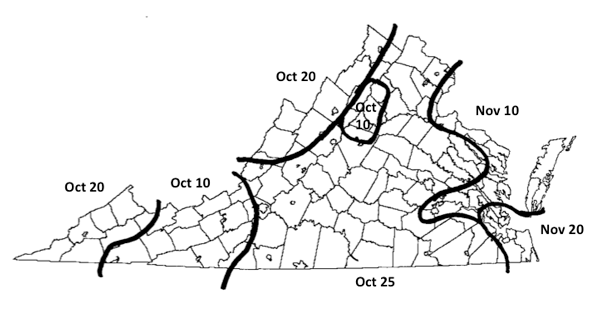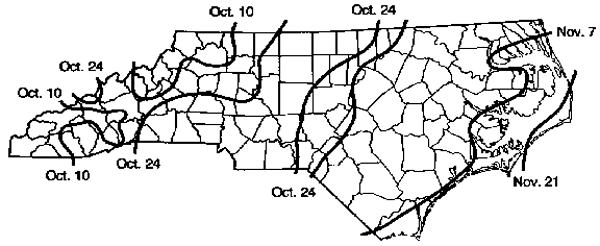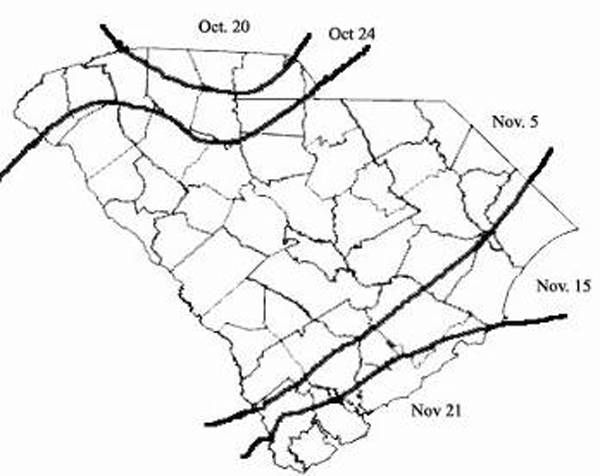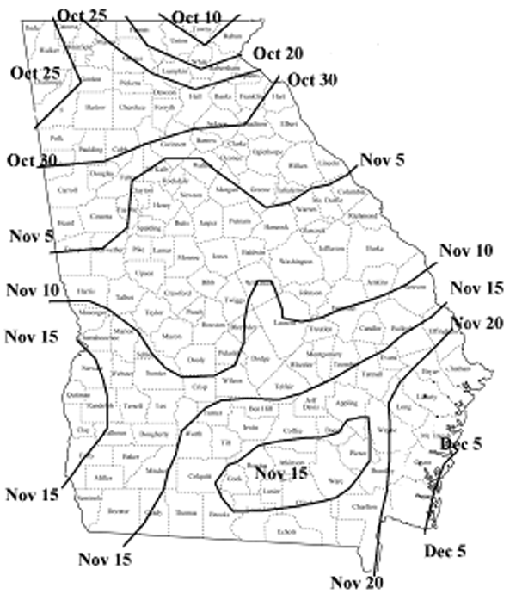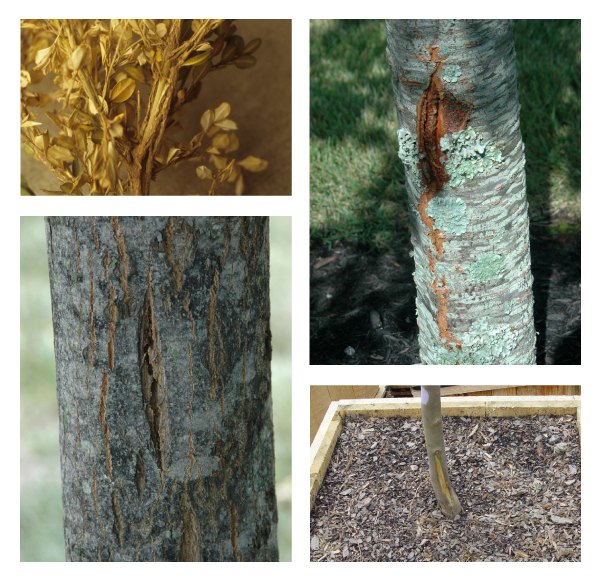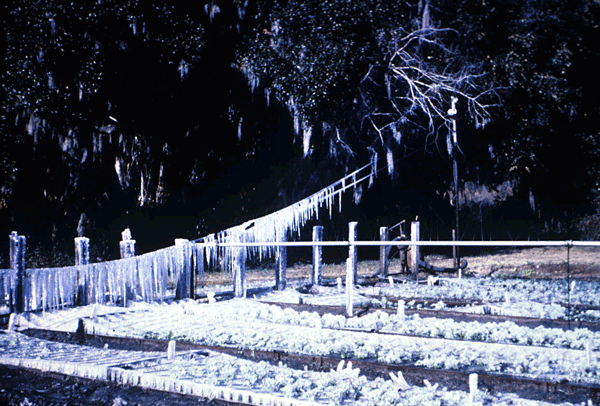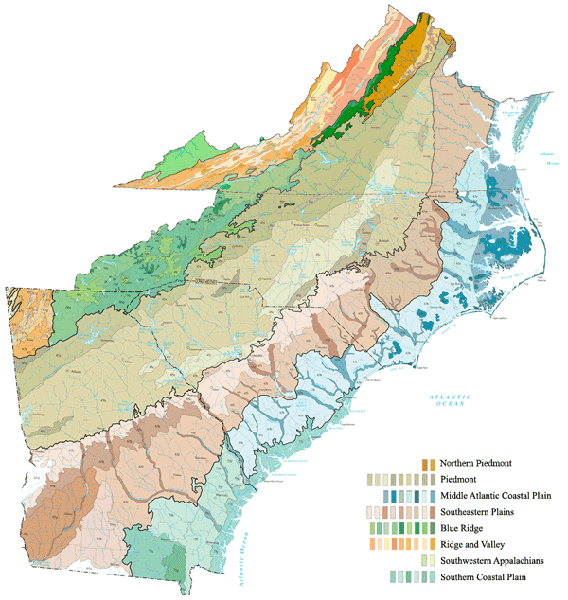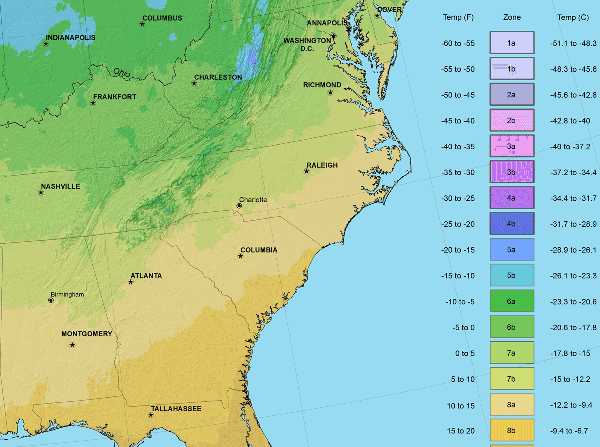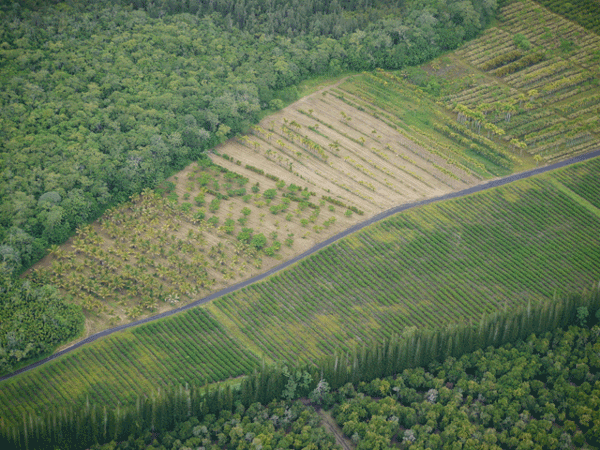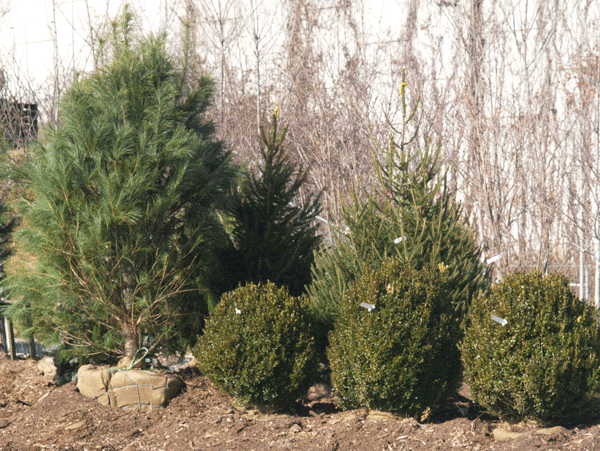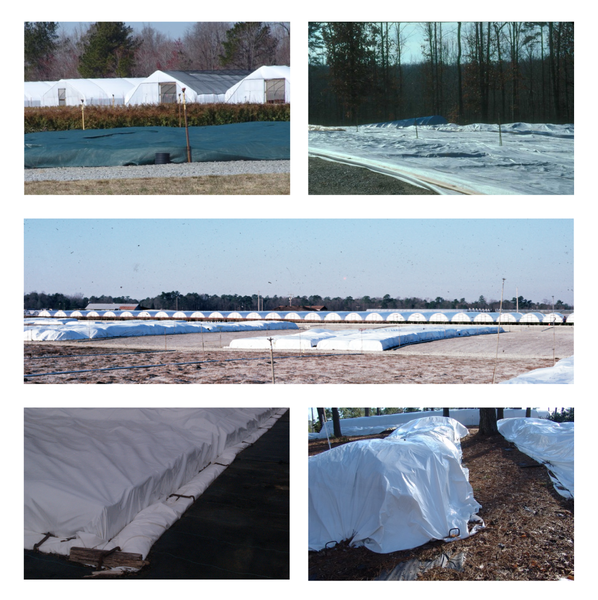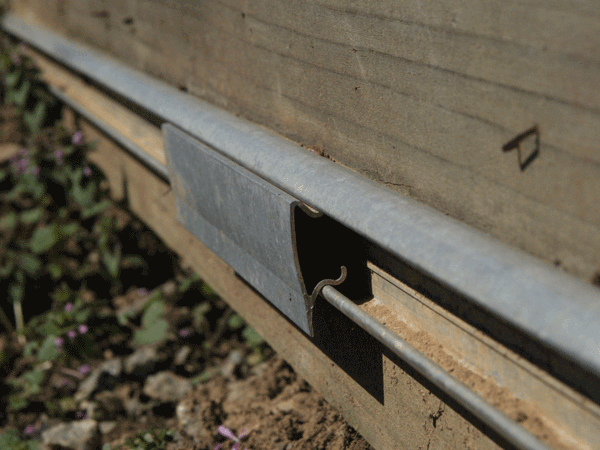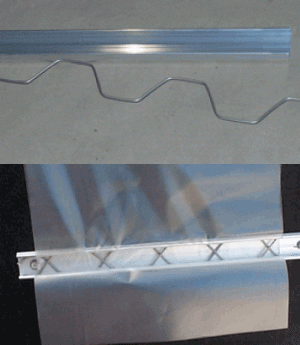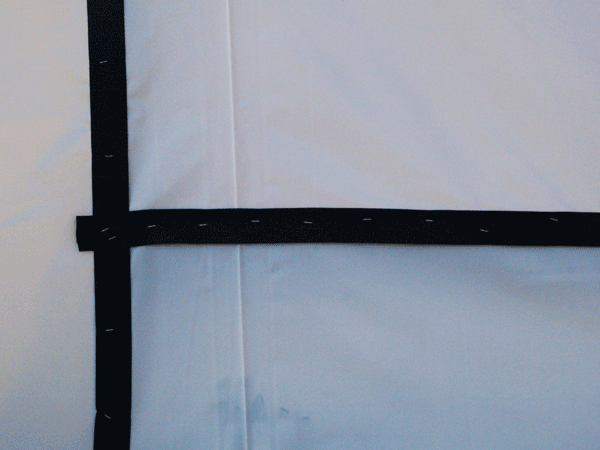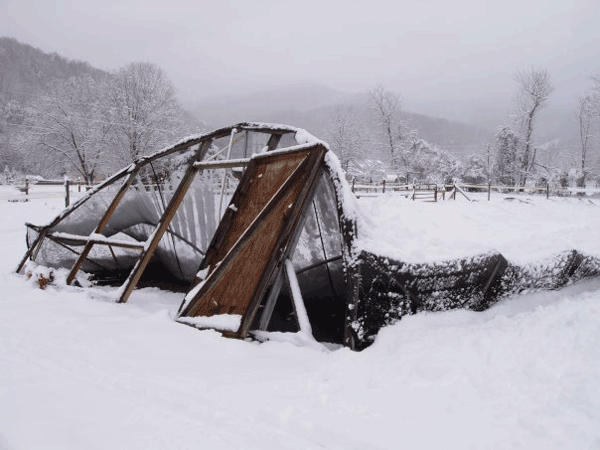Marketable woody nursery crops require more than one production season before they are sold, which means they must survive at least one winter. Successful winter survival means that both the roots and the upper foliage survive freezing temperatures with no death and little damage, ready to resume growth in the spring.
Most plants produce a flush of growth in the spring, and this growth may continue throughout the season. Growth gradually slows in the fall because of cooler temperatures and shorter days. To grow plants more rapidly, we can extend the period of rapid growth by fertilizing, irrigating, and controlling pests; however, plants are less tolerant of low temperatures during spring and early fall.
Nursery plants must meet several physiological requirements if they are to overwinter successfully. To choose the appropriate winter protection techniques, you must also know how plants acquire cold hardiness and how they are damaged by cold temperatures and winter conditions.
Winter Acclimation
Dormancy is suspension of plant shoot growth until internal physiological parameters are met. Plants can cease growth in midsummer and appear dormant. This dormancy, however, may be caused by a combination of drought, high temperature, or a pause in growth after the first growth flush has completed. If water is provided and temperature decreases, growth resumes. As fall begins, growth starts to slow, and vegetative or flower buds are formed for the following year. Decreased photoperiods (shorter days) and lower temperatures at this time induce the first stage of dormancy acclimation, but plants could grow again if photoperiod increases or temperature rises. Photoperiod normally does not increase until the following spring, but temperature can rise in the fall, accompanied by increased rainfall or irrigation, causing late-season growth. Other fall cultural practices such as applying fertilizer, pruning, digging, and controlling light can affect late-season growth. Failure to manage any of these cultural factors to provide proper conditions for inducing dormancy can cause winter injury.
Once an autumn frost is experienced, plants begin the second stage of acclimation and start to become dormant. As dormancy or acclimation progresses, several internal processes within plants affect cell membranes, energy storage, leaf coloration, and abscission in deciduous plants. During winter, plants acquire hardiness at a steady rate until a midwinter maximum is reached. Then, as plants begin to deacclimate, dormancy slowly decreases. Even if photoperiod or temperature increases to optimal levels for plant growth before full dormancy is reached, growth will not occur. When plants begin to deacclimate in mid-to-late winter and dormancy decreases, flower or foliage buds will swell as long as favorable environmental conditions (photoperiod and temperature) are present.
Provenance, or geographic origin of plant material, also affects winter hardiness. Generally, species and cultivars derived from Southern provenances acclimate to cold weather later in the year, acclimate more slowly, and develop less midwinter hardiness than cultivars from Northern provenances (Lindstrom and Dirr, 1989). The degree or rate of acclimation also depends on exposure to cold weather. In the Southeastern United States, wet, warm autumns are common, and some areas do not receive a killing frost until after Thanksgiving. (Figure 1a, 1b, 1c, and 1d). Plants from either provenance may not acclimate well if cold weather is not experienced. If sudden, severe cold weather is experienced without acclimation, damage could occur to all plants. Plants from Southern provenances that are grown farther north might be more likely to deacclimate sooner in late winter when favorable environmental conditions exist. Unfortunately, photoperiod and temperature can be favorable for growth in Northern regions even though the last killing frost has not occurred. Thus, plants can be injured if not protected during this time.
Fertilization
The management of nutrient availability in fall in combination with cold acclimation and subsequent winter hardiness is a complicated subject. Growers must manage nutrient levels without providing an oversupply or causing a deficiency. Plants grown in soilless substrates, such as aged pine bark, require nutrients because pine bark is both a poor nutrient source and a poor storehouse for nutrients once they have been applied. Nutritionally balanced plants have the best chance of withstanding winter conditions. An oversupply of nutrients in the fall combined with above-average rainfall and temperatures can extend the growth period, putting plants at risk of injury if a killing frost occurs unexpectedly. In contrast, an undersupply of nutrients can lead to poor storage reserves for winter and reduced growth during budbreak in spring. Nutrient levels may be managed at an intermediate level by monitoring electrical conductivity (EC) and pH of leachates from containers.
The amount of nutrient salts in a growing medium and their relative availability to plants are quantified by pH and EC values of container leachates. These two diagnostic tools help troubleshoot nutritional status and guide irrigation practices over the growing season (for more information, see The Pour-Through Extraction Procedure: A Nutrient Management Tool for Nursery Crops, NC State Extension publication AG-717. During the growing season, EC values should range from 0.5 mS/cm to 2.0 mS/cm.
As fall progresses, EC values should begin declining toward 0.5 mS/cm, signaling decreasing availability of nutrients. If quick-release granular fertilizer or liquid fertilizer programs are used, which immediately supply soluble fertilizer to the plant, begin withholding fertilizer about six weeks before the average first frost date (Figure 1a, 1b, 1c, and 1d) to ensure proper EC levels. EC levels above 1.5 mS/cm in late September and early October may necessitate increased irrigation to leach high amounts of salts from the substrates. Controlled-release fertilizer (CRF) programs may also require excess leaching if EC levels still remain high at this time.
A general guideline for plant growth has been to pot plants in spring, apply either an eight-to-nine month or five-to-six month CRF, and irrigate container plants as needed during the growing season. By fall, most nutrients from the CRF should have released; thus, EC levels should fall into the lower range mentioned above. Growers pot plants all year round depending on production and labor schedules. When potting in the fall, growers sometimes reduce the amount of fertilizer in order to prevent winter injury. This practice was the focus of a study conducted at NC State University, which found that plants potted from August through October showed no winter injury after receiving either the recommended rate or half the recommended rate of fertilizer prior to overwintering (Ivey et al., 2002). For example, ‘Compacta’ holly (Ilex crenata ‘Compacta’) (USDA hardiness zone 6) and ‘Chindo’ viburnum (Viburnum awabuki ‘Chindo’) (USDA hardiness zone 8) potted in September and October in Raleigh, North Carolina (USDA hardiness zone 7b), received recommended rates of CRF and grew as well as or better than plants potted in March, May, or July receiving the same CRF rates (Ivey et al., 2002). There was no winter injury on any plants after potting during two average Raleigh winters. Plants that received half the recommended rate of fertilizer at potting and then the remaining half a few months later grew poorly regardless of when they were potted during the year. This was due to low EC levels during the entire production cycle. That is, levels of 1.0 to 1.5 mS/cm were never reached for plants receiving half rates of fertilizer; thus, these plants did not receive enough nutrients to grow optimally. For production purposes, try to maintain EC levels at or near 0.5 mS/cm for plants already in production growing into the fall, but apply the recommended rate of nutrients to plants that are newly potted in the fall.
Winter hardiness is aided by uptake of nutrients into foliage of both evergreen and deciduous plants. The presence of adequate levels of potassium in foliage during the fall contributes to plants’ winter hardiness. Foliar analyses from the North Carolina Department of Agriculture and Consumer Services Plant and Soil Testing Laboratory indicate that potassium levels in foliage should have an index of 50 to 75 for most woody ornamentals. For a soilless substrate, a test index value of approximately 50 is adequate. (To obtain South Carolina foliar analyses, consult the Clemson University Agricultural Service Laboratory; to obtain Georgia foliar analyses, consult the University of Georgia Agricultural and Environmental Services Laboratory.) If foliar or substrate values are well below these levels, it may be possible to improve winter hardiness by applying potassium.
How to Calculate Leaching Fractions
The ideal leaching fraction for fall irrigation of container plants is 0.10. For example, if 1 liter (1000 ml or 33.8 oz) is applied to container plants by either overhead or drip irrigation, then only 100 ml (≈ 3.4 oz) should leach from the containers (100 ml ÷ 1000 ml = 0.10 leaching fraction) (3.4 oz ÷ 33.8 oz ≈ 0.10). To measure the amount of water leached from the containers, use two empty containers that are the same size as the containers used in the growing area. Put a plastic bag in each container so it will hold water. Leave one container out in the growing area (call this container 1 or C1). In the other container (C2) place a container plant from the growing area. The bucket called C1 placed out in the open will capture the amount of irrigation water applied; the second bucket, C2, will capture the amount of water that leaches from a plant. Make sure that the seal between the pot with a growing plant and C2 is tight enough to exclude water applied from overhead. Usually this is achieved already by using a similarly sized pot and plastic bag, but check to make sure.
Thirty minutes after the irrigation cycle has been completed for the day, collect and measure the amount of water in each bucket. The water in C1 is the total volume applied, and the water in C2 is the amount leached. When C2 is divided by C1, this number equals the leaching fraction (C2 ÷ C1 = leaching fraction). To test the efficiency of irrigation distribution in the growing area, place a number of C1 pots randomly in the growing area, and measure their volume 30 minutes after the irrigation cycle ends. If there are major differences between pots within the same irrigation zone, the distribution of water might be uneven.
If you wish to apply a complete NPK fertilizer in the fall, wait until aboveground plant parts are fully dormant. After deciduous plants have dropped their leaves, a fall fertilizer application is usually safe. A moderate level of balanced fertilizer should not cause plants to break dormancy or reduce hardiness once they have acclimated. Controlled-release fertilizers release nutrients through a diffusion-based coating of prills to guard against nutrient release during winter. Vent overwintering structures on unseasonably hot winter days to reduce high temperatures. This strategy will prevent early growth and may decrease the likelihood of nutrients being released early from fertilizer prills.
Watering
In fall, apply enough irrigation water to container plants to capture a 0.10 leaching fraction (see How to Calculate Leaching Fractions). Leaching fractions are calculated by dividing the amount of irrigation water that leaches from the container by the total volume of irrigation water applied. This method also provides a tool to gauge whether the volume of water intended to be applied is actually being applied.
Uneven water distribution can be caused by poor irrigation design and layout or irrigation orifices that are cracked, clogged, or worn. Growers can alter plant layout, adjust irrigation timing, or repair irrigation components to reduce or compensate for uneven water distribution.
The portion of the stem that enters the soil or potting substrate is the last part of the plant to attain full winter hardiness. Early frosts may cause bark splitting in this area of the stem (Figure 2). In an overwintering study of evergreen azaleas, reduced irrigation after August 30 significantly increased lower stem cold hardiness and prevented premature bark splitting (Anisko and Lindstrom, 1995). Reduced irrigation in the fall decreases the chances of a late-fall growth flush and subsequent frost injury. Plants subjected to very dry conditions during the fall, however, are less able to withstand severe winter conditions than those receiving reduced irrigation, even if ample water is provided during early winter. Drought conditions in the fall reduce root storage of nutrients and carbohydrates. As a result, plants may not accumulate enough stored energy for bud break and shoot expansion in the spring. Therefore, monitoring the volume of irrigation applied to maintain a 0.10 leaching fraction is important, both to reduce nutrient availability and to provide intermediate amounts of moisture to facilitate the physiological processes necessary for acclimation to cold weather.
Regardless of the overwintering protection method used—and especially if plants are overwintered in the open—plants need water occasionally during winter. Irrigation before a hard freeze will accomplish two things. First, as water freezes and solidifies, it gives off heat that can be captured in the overwintering structure and used to maintain or moderate cold temperatures. Even the gravel on container pads or the surrounding soil holds water that will freeze and release heat that can be trapped under cover. Second, watering plants before a freeze will aid survival by allowing plants to store water. When container substrates freeze solid, plants cannot absorb water to transpire, and they will desiccate instead.
Using irrigation over outdoor growing blocks as a winter-protection technique is feasible only if the plants have shoot growth that has not quite hardened and temperatures are expected to drop near freezing. This technique is frequently used with peaches, apples, and strawberries in spring to protect flower buds from freezing. For nursery crops, this procedure can be used successfully in fall and spring to avoid damage to soft shoot growth (Figure 3). Irrigation must be applied before ambient temperatures reach 32°F (0°C) and must be continued through several daylight hours during the next day, until the ice begins to melt. If discontinued sooner, freeze damage is likely to occur. However, icing-in woody nursery crops also has disadvantages because the heavy coat of ice can break limbs. Unprotected plants (those with soft shoot growth) that suffer an early-fall or late-spring frost generally lose the current flush of growth. If soft shoot extension is 6 inches or more, you may need to prune off dead growth. Apply a fungicide if cold-damaged shoot tips occur. The next flush usually produces multiple shoots from each shoot apex.
Pruning
Late-season pruning may stimulate bud break, causing new growth that does not harden off before cold weather. Avoid pruning within six weeks of the average first frost date. Extensive late-fall pruning also creates wounds that do not close until active growth begins in spring. This may make it easier for decay organisms to become established in the wounds.
Light
Both intensity and duration of light affect plant dormancy. Plants acclimate more slowly in the shade than in the sun. For this reason, mountain growers remove shade in September to help harden plants. Removing shade in the fall induces more rapid acclimation and decreases the potential for splitting, as shown in Figure 2. For nurseries located in the piedmont and coastal plain ecoregions (Figure 4), considerable growth occurs throughout the fall. Removing shade from actively growing plants may cause sun scald on succulent shoots that are accustomed to shade. Remove shade to increase hardiness some time during the short period after new growth hardens but before the arrival of extended cold. If plants are to be moved to a sheltered, shaded area, do so only after they have fully hardened.
Apply mulch for winter protection only after plants have hardened in response to shorter days and initial frosts. Mulching before this date may insulate the plants and reduce acclimation by keeping soil temperatures high and soil water plentiful. In the Blue Ridge ecoregions (Figure 4), both of these practices are usually performed after November 15. In other ecoregions, these steps are usually completed just before Christmas or before a severe cold front with predictions of extended freezing temperatures.
Turn off supplemental lighting in the fall if plants are to be overwintered in unheated areas. Shorter days are just as essential as reduced fertility and properly managed irrigation and temperature if a plant is to harden properly.
Temperature
As temperature drops, plant growth slows, and many nursery plants begin winter acclimation and dormancy. Cool temperatures and shorter days initiate the first phase of hardening, allowing plants to withstand a frost but not a hard freeze (Figure 5).
In a study to determine environmental factors that predicted the lowest winter survival temperature of six deciduous shade trees, researchers found that day length, the number of hours accumulated above 68°F (20°C) since August 1, and the number of hours accumulated below 50°F (10°C) since August 1 were good indicators of winter hardiness (Anisko et al., 1994). This model differs from fruit tree prediction models because it predicts winter hardiness rather than bloom time. If temperature is recorded at your nursery or is easily obtained from your local county Extension agent, then this information might be beneficial to decide whether a midwinter cold front might damage plants. If temperatures have been below 50°F (10°C) for multiple days after August 1, then plants may be able to withstand extended cold periods. However, if temperatures were above 68°F for many days, which occurs quite often in the coastal ecoregions (Figure 4), then plants might be less hardy and might require extra cover or another cold protection strategy. Plants can be protected from cold by the use of covered houses, frost blankets, or other temperature-moderating practices (see discussion of these practices in “Protection Techniques” section below).
Table 1. Lowest surviving temperature (°C) of leaves and stems for various species and cultivars of Abelia.
| Species | Cultivar | Overall Hardiness Rank | Stem | Leaf |
|---|---|---|---|---|
| A. × grandiflora | –24.8 | –23.3 | ||
| A. × grandiflora | ‘John Creech’ | 1 | –26.0 | –21.0 |
| A. × grandiflora | ‘Prostrata’ | 2 | –24.8 | –15.8 |
| A. × grandiflora | ‘Little Richard’ | 3 | –23.3 | –18.8 |
| A. × grandiflora × A. schumannii | ‘Sherwoodii’ | 4 | –24.0 | –16.5 |
| A. × grandiflora | ‘Compacta’ | 5 | –23.3 | –15.8 |
| A. × grandiflora | ‘Golden Glow’ | 6 | –22.5 | –16.5 |
| A. × grandiflora | ‘Confetti’ | 7 | –22.5 | –14.0 |
| A. × grandiflora | ‘Francis Mason’ | 8 | –21.8 | –18.8 |
| A. × grandiflora | ‘Edward Goucher’ | 9 | –16.0 | –18.0 |
| Source: Scheiber, S. M., C. D. Robaker, and O. M. Lindstrom. 2002. Stem and leaf hardiness of 12 Abelia taxa. J. Environ. Hort. 20:195-200. | ||||
Hardiness Ratings
Not all plants can withstand the same degree of cold temperature. Plants are usually ranked according to a USDA hardiness zone map (Figure 6). Each zone represents the average annual extreme minimum temperature for an area, reflecting the temperatures recorded for each of the years 1976 through 2005. Hardiness zones, however, do not take into account the number of times this average temperature is reached each year or the duration of the average temperature while it is occurring. Western North Carolina and the Blue Ridge ecoregion are generally ranked as USDA hardiness zone 6b or 7a in a normal winter, whereas the piedmont and coastal ecoregions are ranked as 7b and 8a respectively (Figure 4 and Figure 6). Local conditions such as air drainage, elevation, slope, and proximity to large bodies of water can influence temperatures within a small geographical area, and the new USDA plant hardiness zone map has taken those factors into consideration.
Hybrid rhododendrons have a flower bud hardiness rating system. The temperatures that correspond to each rating are the lowest temperature the flower bud can withstand and still open in spring. Therefore, plants rated as H-4 or H-5 will need some protective cover in winter in most ecoregions of the Southeastern United States.
Table 2. Flower Bud Hardiness Rating System for Hybrid Rhododendrons
| Rating | Minimum Temperature (°F) |
|---|---|
| H-1 | –25 |
| H-2 | –15 |
| H-3 | –5 |
| H-4 | 5 |
| H-5 | 15 |
Hardiness zone ratings for plants assume that the plant is established and growing well prior to experiencing the minimum cold temperatures for that zone, so be cautious when categorizing plants by hardiness zone. Plants grown aboveground in containers do not benefit from the insulating properties of soil. Therefore, some plants that may be perfectly hardy when grown in the ground may not be hardy when grown in containers. Shoots, roots, leaves, and buds differ in their ability to withstand cold temperatures. At a given temperature, flower buds may die while leaf buds remain unharmed. In Table 1, various cultivars of Abelia × grandiflora are ranked for stem and leaf cold hardiness; however, these results are for plants established in the landscape (Scheiber et al., 2002). They are presented here to demonstrate how cultivars within a species or hybrid can differ with respect to cold hardiness. Plants listed as more cold hardy in Table 1 generally withstood colder temperatures earlier in the year, stayed dormant longer, and withstood colder temperatures later into winter and spring the following year.
Not all plants respond similarly to cold temperatures, and differences exist between plants that are very closely related. Roots are often damaged at higher temperatures than shoots on the same plant (Table 3).
Container-grown ornamentals and plants that are not normally hardy at your nursery must be protected during the winter. Container-grown plants and plants that are not fully dormant need more protection than is indicated by a plant hardiness zone map (Figure 6).
| Taxa | Studera | Havisb | |
|---|---|---|---|
| Immature | Mature | All | |
| Acer palmatum ‘Atropurpureum’ |
|
14 | |
| Buxus sempervirens |
27 |
15 | |
| Cornus florida | 21 | 11 | 20 |
| Cotoneaster horizontalis | 15 | ||
| C. adpressa praecox | 10 | ||
| C. dammeri | 23 | ||
| C. dammeri ‘Skogsholmen’ | 19 | ||
| C. microphylla | 25 | 9 | |
| Cryptomeria japonica | 16 | ||
| Cytisus praecox | 15 | ||
| Daphne cneorum | 20 | ||
| Euonymus alata ‘Compacta’ | 19 | 7 | |
| E. fortunei ‘Argenteo-marginata’ | 15 | ||
| E. fortunei ‘Carrierei’ | 15 | ||
| E. fortunei ‘Colorata’ | 5 | ||
| E. fortunei v. variegeta | 23 | 12 | |
| E. kiautschovica | 21 | 16 | |
| Hedera helix ‘Baltica’ | 15 | ||
| Hypericum spp. | 23 | 18 | |
| Ilex cornuta ‘Dazzler’ | 18 | 18 | |
| I. crenata ‘Convexa’ | 20 | ||
| I. crenata ‘Helleri’ | 23 | ||
| I. crenata ‘Hetzi’ | 20 | ||
| I. crenata ‘Stokesii’ | 20 | ||
| I. × meserveae ‘Blue Boy’ | 3 | 9 | |
| I. × ‘Nellie Stevens’ | 23 | 14 | |
| I. opaca | 2 | 9 | 20 |
| I. ‘San Jose’ | 21 | 18 | |
| Juniperus conferta | 12 | 10 | |
| J. horizontalis | 0 | ||
| J. horizontalis ‘Douglasii’ | 0 | ||
| J. horizontalis ‘Plumosa’ | 12 | -4 | |
| J. squamata ‘Meyeri’ | 12 | ||
| Kalmia latifolia | 16 | ||
| Koelreuteria paniculata | 16 | -4 | |
| Leucothoe fontanesiana | 19 | 5 | |
| Magnolia × soulangiana | 23 | ||
| Magnolia stellata | 21 | 9 | 23 |
| Mahonia bealei | 25 | 12 | |
| Pachysandra terminalis | 15 | ||
| Picea glauca | -10 | ||
| P. omorika | -10 | ||
| Pieris floribunda | 5 | ||
| P. japonica | 16 | 10 | |
| P. japonica ‘Compacta’ | 15 | ||
| Potentilla fruticosa | -10 | ||
| Pyracantha coccinea ‘Lalandei’ | 25 | 18 | 18 |
| Rhododendron ‘Gibraltar’ | 10 | ||
| R. carolinianum | 0 | ||
| R. catawbiense | 0 | ||
| R. Exbury Hybrid | 18 | ||
| R. ‘Hino Crimson’ | 19 | ||
| R. ‘Hinodegiri’ | 10 | ||
| R. ‘P.J.M. Hybrids’ | -10 | ||
| R. prunifolium | 19 | ||
| R. ‘Purple Gem’ | 16 | ||
| R. schlippenbachii | 16 | ||
| Stephanandra incisa ‘Crispa’ | 18 | 0 | |
| Taxus media ‘Nigra’ | 10 | ||
| T. × media ‘Hicksii’ | 18 | -4 | |
| Viburnum plicatum tomentosum | 19 | 7 | |
| V. carlesii | 15 | ||
| Vinca minor | 15 | ||
|
aStuder, E. J. et al, 1978.↵ bHavis, J. R., 1976.↵ Note: Differences in root-killing temperatures for the same taxa were most likely caused by variations in root maturity and experimental procedure. Source: Principles, Practices and Comparative Costs of Overwintering Container-Grown Landscape Plants. Southern Cooperative Series Bulletin 313, May 1986. David J. Beattie, editor. Pennsylvania State University, Agricultural Experiment Station, University Park, PA. |
|||
Frost Burn
Damage can occur when frost forms on the leaves of evergreen plants such as hemlock, mountain laurel, azalea, rhododendron, camellia, tea olive, and others. If frost-covered shoots are exposed to bright sunlight, freeze damage or “burn” may occur. Foliage usually turns bright yellow a few days after freeze damage because of chlorophyll degradation. This damage is usually easy to diagnose because the inner leaves (those in the shade) are not affected. Freeze burn causes no long-term damage; once normal growing conditions resume in the spring, leaves will return to a normal green color.
Strategies and Techniques to Protect Plants
- Push pots together in large blocks.
- Wrap outside edge of plants with microfoam, spunbond nonwoven polyester material, or pine straw bales to protect from wind. No protection on inside containers.
- Mulch in and around plants on the inside of the block using:
- Newspaper
- Pine straw, hay, or some other grain
- Leaves or other composted material
- Cover blocks of plants with microfoam or spunbond nonwoven polyester fabric.
- Cover fabric with white polyethylene.
- Use mulches under the fabric.
- Overwinter plants inside a quonset-style greenhouse or similar structure.
- Place single-layer white poly cover on house.
- Push plants close together with no further protection.
- Cover plants inside structure with microfoam or spunbond nonwoven polyester.
- Heal plants in with mulch.
- Place double-layer white poly cover on house with inflator fan to create an insulating dead-air space between plastic covers.
- Also cover plants with microfoam or spunbond nonwoven polyester.
- Provide an independent heat source inside the house:
- Portable forced-air heater that runs on fuel or electricity
- Permanent propane, electric, or wood-fired heater
- Place single-layer white poly cover on house.
Note: Organization of ideas based on Dunwell and McNeill, 2009.
Wind Burn and Desiccation
When plants lose moisture through leaves more rapidly than it can be absorbed by the roots, permanent damage can occur. On broadleaved evergreens, this moisture loss results in curled leaves with brown or dead tips and edges. On boxwood and conifers, foliage may turn bronze before leaf tips turn brown or black.
Winter desiccation (drying out) causes more plant loss than freeze injury in unprotected nursery stock. This condition is expected at very windy sites, but cold, sunny days with little wind can also cause severe desiccation. Wind injury is not always fatal, but wind-injured plants may not be marketable in the spring. If the soil or planting substrate freezes, no moisture is available to leaves and shoots. Thus, plants can be killed to the soil line by desiccation even if temperatures are not low enough to kill them otherwise.
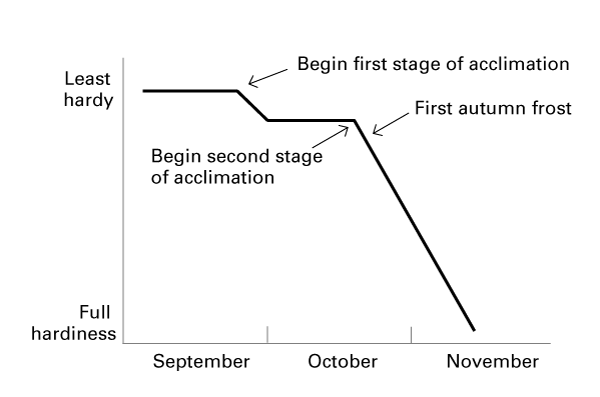
Figure 5. A typical pattern of acclimation to freezing temperatures by woody plants. Temperatures and dates vary depending on hardiness zone and plant species.
Source: Principles, Practices and Comparative Costs of Overwintering Container-Grown Landscape Plants. Southern Cooperative Series Bulletin 313, May 1986. David J. Beattie, editor. Pennsylvania State University.
Protection Techniques
There are a variety of winter protection techniques that progressively increase plant insulation and protection from cold weather (see Strategies and Techniques to Protect Plants). The cost for each technique increases as the degree of protection increases. In any nursery setting, any number of these methods might be used simultaneously to protect plants, depending on the general cold hardiness of the inventory.
Field Nurseries
When planning a field nursery, select a site with physical characteristics that help reduce plant damage during winter months. For example, avoid sites that have excessive wind, frost pockets, rodent populations, and abnormally early warming in the spring or during winter thaws. Plant growth may be extended into the fall if plantings are in soils that remain moist into late fall. For example, bottomlands near a river or creek or drainage areas for large portions of a nursery may encourage late-season growth, especially when temperatures are abnormally warm. Avoid planting trees or shrubs that are well known for late-season growth (such as crape myrtle [Lagerstroemia], Japanese cedar [Cryptomeria japonica], boxwood [Buxus], and some broadleaved evergreen hollies [Ilex]), as they may continue to grow until the first frost and lose tender foliage.
Wind barriers can help prevent windburn if they are placed properly. Windbreaks block wind and raise it upward to reduce air movement across plants (Figure 7). A windbreak will protect plants on the leeward side (away from the wind) for a distance of five times its height. Poorly placed windbreaks can create swirls, resulting in more damage than protection. Plants that are dug and overwintered need to be placed in shade, with the root balls heavily mulched to protect the root system from freezing temperatures (Figure 8).
Table 4. Weights of spunbond nonwoven polyester fabrics and estimated thermal protection gained when used.
| Ounces / yd2 (grams / m2)a | Temperature (°F) increase under cloth |
|---|---|
| 0.5 oz (17 g) | 2–4 |
| 1.0 oz (34 g) | 4–6 |
| 1.5 oz (51 g) | 6–8 |
| 3.0 oz (102 g) | 10 |
| 8.0 oz (273 g) | Unknownb |
| a↵Ounce per square yard designations are used to identify materials in the United States. To convert metric measurements to U.S. measurements, divide grams by 28.4 to derive ounces. Then divide the number of ounces by 1.2 to convert to ounces per square yard. Ounces per square yard = (grams ÷ 28.4) ÷ 1.2. For example, 17 grams per square meter = 17 ÷ 28.4 = 0.6; then 0.6 ÷ 1.2 = 0.5 ounces per square yard. b↵8 ounces per yard was the heaviest fabric found in North Carolina. This fabric has not been tested experimentally for thermal protection of ornamentals. It may be too expensive, heavy, or difficult to work with and store for the amount of protection it bestows. |
|
Seedbeds and Liner Nurseries
Small or recently set plants usually have a reduced root system. Because of their size and small root systems, these plants are more likely to “heave” out of the ground, desiccate, and die during the many freeze-and-thaw cycles in a normal winter in the Blue Ridge ecoregion. Fewer frost-heaving problems occur in piedmont and coastal ecoregions (Figure 4).
To moderate soil temperatures and safeguard against frost-heave damage, mulch heavily during the first winter after germinating or transplanting. Soils with a higher content of clay or organic matter tend to be more prone to frost heaving than sandy soils. Best results are obtained by mulching with 6 to 8 inches of hardwood leaves, pine needles, or clean straw after the plants are fully dormant. Covering plants with a single layer of spunbond polyester or polypropylene fabric, or with two layers of either fabric with mulch between them, has also provided good winter protection (Pellet and Heleba, 1994) (Table 4; Figure 9). Heat may build up under these fabrics, however, causing plants to break dormancy early. Weed seeds in the mulch may also cause pest problems in spring. Overwintering practices such as these must be checked periodically through the winter and biweekly near spring to inhibit early budbreak.
Container Nurseries
Container plants present many special winter survival problems. The two major problems are desiccation and a lack of root hardiness. Desiccation is the most common winter injury of container-grown evergreen nursery crops. If broadleaved evergreens are not watered adequately, they often turn bronze, and their shoots die later. When temperatures remain below freezing for an extended period of time, the root ball in the container can freeze completely, making water unavailable to the roots. To remedy this problem, irrigate adequately during the winter before extended periods of freezing temperatures and during prolonged cold, sunny, or windy conditions. If containers are irrigated to their capacity, an additional thermal resistance to freezing is provided.
Generally, plant roots are not as hardy as shoots and die at much higher temperatures than shoots do (Table 3). Soil provides insulation when ambient air temperatures are low. Roots in unprotected containers are more vulnerable to freezing temperatures. Plants that endure freezing temperatures in the landscape may have roots that would normally be killed at temperatures of 20°F to 25°F. In Virginia, North Carolina, South Carolina, and Georgia, soil temperatures rarely drop below 20°F, except in the very uppermost soil horizon.
Successful winter protection systems moderate temperatures at the root zone while maintaining accessibility for watering. Some winter protection systems do a better job of moderating temperatures at the root zone than for the shoots. This leads to partial or complete dieback of the aboveground portion of the plant, but a new flush of growth in the spring might remedy the situation. However, if many roots die over the winter, it is less likely that the plant will outgrow this malady in spring. If a root system is diminished by low temperatures, new growth might be followed by wilting because the root system cannot support the water needs of the aboveground plant portion. If the system does not allow easy accessibility for watering, then desiccation will cause more winter injury than cold temperatures. In either case, plant loss occurs.
Shade also protects the leaves of evergreens from sun and wind, reducing water loss on bright, cold days. Spring frost burn, which occurs when the sun shines on frozen or frost-covered leaves, is also prevented by shade.
A variety of winter protection techniques have been used successfully for container-grown plants. Within the Blue Ridge ecoregion (Figure 4), for example, nursery operators that grow only very hardy container plants may cluster them together in a sheltered, shaded location, mulching over the tops of the containers or placing bales of straw around the perimeter of the clustered pots (Figure 10). Chopped newspaper placed between two sheets of white polyethylene plastic has provided excellent protection for small plants in containers, especially perennials (Pellet and Heleba, 1994). The bales, mulch, and newspaper act together to create a dead air space around the plants. Heat given off by the system at night is trapped by this dead air space, and air around the plants’ roots remains warmer than the air around the tops of the plants. Chopped newspaper can become wet, heavy, and difficult to remove in spring, while hay and other suitable insulating materials may introduce weed seeds into production.
Avoid laying plants sideways for long periods during the winter because buds and shoots will turn upward, resulting in asymmetrical growth. If dormant trees are laid over and exposed to full sunlight, sun scalding on the main branches and trunk may also occur. This type of winter damage is often mistaken for mechanical injury.
In the southeastern plains ecoregion (Figure 4) of Virginia, North Carolina, South Carolina, and Georgia, container-grown plants are pushed tightly together in blocks. Some nursery operators wrap the container blocks with plastic or paper to reduce air movement through the blocks (Figure 11).
Many growers have experimented with structureless winter protection methods. In USDA hardiness zones 8 and 9, growers have successfully protected plants by preparing them as if they were going to be placed into a structure. Growers wait until a severe cold front is coming through; then they lay a thermal blanket only, a cover of white copolymer film only, or a combination of white copolymer film and a thermal blanket over the top of the plants. The sides are securely fastened, and the cover is checked to make sure it is not punctured (Figure 12).
In Figure 12, various sizes and configurations of plants are covered by a combination of row covers or thermal blankets and then copolymer. All of these methods reduce desiccation. Combining row covers with copolymer can provide approximately the same freeze protection given by structures. Notice the clamps (center, bottom) used to secure the plastic covering to the ground. Other devices can include bags, buckets, or containers filled with rocks, water, or sand.
Problems with this technique include plant abrasion from the plastic flapping in the wind, stem breakage if a heavy ice storm or snowstorm occurs, rodents, and buildup of heat and moisture under the cover. Other growers have used the structureless system, covering plants with shade cloth or fabric (Table 4; Figure 12).
Research with porous row cover fabrics indicates that they protect some nursery crops as well as if the crops were placed in winter protection structures. Shade cloth or row cover fabrics reduce sunlight and wind movement around evergreen and broadleaved evergreen plants. This reduces desiccation and discoloration of foliage, resulting in greener plants with greater sales appeal for early spring marketing. During periods of bright, sunny, warm days, remove the fabrics but keep them accessible. Removal helps reduce early shoot development.
Many nursery operators build either temporary overwintering structures (for more information, see “Low Investment Propagation/ Winter Protection Structure,” NC State Extension publication HIL-404) or larger, long-term structures that serve as both growing spaces and overwintering structures (Figure 13a, Figure 13b, and Figure 14). Orientation of wintering structures is not as critical for structures covered with white copolymer plastic as it is for those covered with clear plastic. However, houses oriented north to south will be somewhat warmer in winter than those facing east to west. During the growing season, plants are spaced accordingly in the structures, and irrigation is laid out to accommodate the plants. In winter, plants are pushed together, and the structure is covered with either shade cloth (if the nursery is in the coastal plains ecoregions and broadleaved evergreens are being grown) or white polyethylene plastic, depending on the ecoregion where the nursery is located and the hardiness of the plants being grown (Figure 13a and 13b). Plants that are fully dormant or have hardened are placed in temporary shelters, which are then covered with a plastic film. To ensure the greatest degree of hardiness, do not cover houses until the onset of extended cold winter temperatures is imminent. Plants within the structure may also be covered with a thermal blanket (Table 3; Figure 14).
Plastic is fastened to overwintering structures by using vinyl batten tape, mesh batten tape, or a locking strip that uses wiggle wire or an interlocking aluminum mechanism (Figure 15a, 15b, 15c, and 15d). Even thin strips of wood batten can be fastened to baseboards to hold plastic.
Approximately six weeks to a month before covering either structures or blocks of plants, apply preemergence herbicide to container plants to control weeds and to the structure to prevent weeds germinating in winter. Currently, there are no preemergence herbicides labeled for use in covered structures; therefore, make sure all overwintering systems are weed free prior to covering, to prevent winter weed growth.
If CRFs were used during the growing season, use the pour-through extraction procedure discussed in publication AG-717 to test the EC of leachate from containers. Leachate EC should be below 0.5 mS/cm. If substrate is taken from the container to do a 1:2 dilution, collect 50 cc (~¼ cup) of substrate and add 100 ml (~½ cup) of distilled water. The EC reading should be less than 0.2 mS/cm. If conductivity levels are higher than these values, leach the containers by applying approximately 1 inch of irrigation. Check the containers during the winter, and do not let them become excessively dry. Random testing of containers in winter-protection houses using the pour-through procedure may indicate the need for further irrigation.
Shortly before being covered, plants must be thoroughly watered and sprayed with a fungicide to prevent infection by diseases that are active at the low temperatures and high humidity found in overwintering structures. Once the plant foliage has dried, the structures may be covered. Because temperature moderation is key to successful overwintering, the most popular covering material in Virginia, North Carolina, South Carolina, and Georgia is 4-mil or 6-mil white copolymer plastic film. The white film partially prevents light penetration, whereas clear film allows total light infiltration. Thus, temperature increases less during the day in white-covered houses than in clear-covered houses. At night, temperatures fall sharply to a few degrees above the ambient outside temperature; however, the difference between day and night temperatures is much less in white-covered houses than in clear-covered houses. These large temperature swings can damage plants in houses covered with clear plastic film.
Make arrangements to ventilate overwintering structures. A ventilation fan activated by a thermostat and mounted on the leeward end of the house, with louvers on the windward end, will provide the most consistent ventilation. If ventilation is provided by opening end doors, air movement at plant height must be blocked and directed to the upper portions of the house to reduce air movement around plants. Some growers ventilate houses by cutting progressively larger holes in the poly film beginning in late winter (Figure 16).
In the right-hand picture of Figure 16, the bottom halves of the plastic panels were left in place to prevent drying of plants. This might not be possible with some greenhouse construction and is not necessary, but it does distribute irrigation evenly due to lack of wind disturbance at plant level.
Operators of nurseries located at elevations lower than 2,000 feet above sea level can successfully overwinter plants if they ventilate greenhouses covered in clear plastic on hot days and irrigate regularly during the winter. Less hardy plants or colder locations may require the use of supplemental heat (such as wood-fired water heaters, forced air, electric or vented propane heaters) or more insulation, such as spunbond polyester thermal blankets or inflated double-poly houses.
All nursery operators who protect plants in overwintering structures must make provisions for snow and ice. Unless overwintering structures have sufficient structural strength, they may collapse during a snowstorm (Figure 17a and Figure 17b). The design of the structure, the spacing of bows, and the gauge of steel used to construct the bows dictate how much snow accumulation each structure can withstand. A gothic-style structure accumulates less snow and may be more structurally sound than the common quonset-style structure. If snow is imminent, prepare for it by securing a backup nonelectric heating system. A fuel-powered forced-air system, an unvented kerosene heater, or a woodstove would work. Obtain backup fuel supplies. Make sure there is an oxygen supply for combustible heating systems by leaving a vent or door slightly ajar; otherwise, the heating system will fail. Remove any shade cloth covering the structures because shade coverings can cause an inordinate amount of snow to accumulate quickly, leading the structure to collapse sooner than expected (Figure 17a and Figure 17b).
Usually, snow and ice storms are not associated with severely low temperatures, so elevating temperatures in the greenhouse above freezing does not require great effort. If snow is accumulating slowly, use a long-handled broom to sweep it off the structures. This may take some time and require some labor. Shut off inflator fans to allow double poly layers to touch, which allows heat in the structure to contact the snow cover and start melting it. Turn on the heating system and melt the snow from the inside of the structure. If there are many houses and few people to manage them, begin early, especially if the heating system is better at preventing snow buildup than at melting large accumulations. One last option is to cut the plastic and let the snow accumulate on the plants inside the structure. This will not cause freeze injury because snow is an insulator, but the weight of the snow may harm the plants.
A snowstorm is the leading edge of a cold front passing through; thus, the bitter cold of the days following a snowstorm can injure unprotected plants. Plants and overwintering structures that have been crushed by tons of snow are expensive losses that can be prevented with adequate planning. NOTE: Before winter, always revisit insurance coverage for catastrophic loss due to weather events.
In spring, remove row covers as soon as possible so heat buildup under cover does not promote excessive, early bud swelling. However, make sure to remove covers late enough to avoid subfreezing conditions that can damage roots and shoots. If active shoot growth begins in enclosed structures, uncovering the plants will cause frost damage. If a large majority of plants have leafed out, then the structure might need to stay covered until the last frost date. Leaf and shoot expansion under the low light conditions of white copolymer film will be wide and thin. When the film is removed, the new growth should be shaded for several weeks to prevent sunscalding. Dates for covering and uncovering vary from one location to another and from one year to the next. Growers must develop an intuitive feeling for the proper timing of these activities.
Crop protection over the winter requires growers to manage nutrients, irrigation, and temperatures to moderate growth, decrease desiccation, and limit cold injury. This publication has provided an overview of the biological processes involved in growth and onset of dormancy in ornamental nursery plants. It has also provided some examples of how to protect plants when cold temperatures occur. Each nursery will have to assess the proper combination of plant growth cessation in the fall with protection-cover technologies to limit crop injury and prepare plants for optimal growth in the spring. Visit other nurseries in your ecoregion within the Southeast to see how other growers accomplish this task. Build a relationship with other growers and especially with your county’s Extension agent responsible for serving the commercial horticulture industry. The relationships created with employees, other growers, and county Extension agents may be the best crop protection a grower can have.

Figure 11. Pushing container blocks tightly together and wrapping them with plastic or paper (left) was the predominant winter protection technique before overwintering structures became popular. Some growers in more southerly ecoregions use recessed holding beds (right) to utilize natural insulation properties of the ground.

Figure 17b. Winter protection houses collapsed by snow load. The greenhouse on the right side was covered with shade cloth, which accumulates snow load more quickly than plastic. The house covered with plastic on the left side also collapsed, although not as severly. These collapses occured within hours of snow beginning to fall.
References
Anisko, T. and O. M. Lindstrom. 1995. "Reduced water supply induces fall acclimation of evergreen azaleas." J. Amer. Soc. Hort. Sci. 120:429-434.
Anisko, T., O. M. Lindstrom, and G. Hoogenboom. 1994. "Development of a cold hardiness model for deciduous woody plants." Physiologia Plantarum. 91:375-382.
Dunwell, W. and R. McNeill. Overwintering nursery crops. University of Kentucky College of Agriculture. Accessed October 6, 2009.
Ivy, R. L., T. E. Bilderback, and S. L. Warren. 2002. "Date of potting and fertilization affects plant growth, mineral nutrient content, and substrate electrical conductivity." J. Environ. Hort. 20:104-109.
Lindstrom, O. M. and M. A. Dirr. 1989. "Acclimation and low temperature tolerance of eight woody taxa." HortScience. 24:818-820.
Pellett, N. and D. Heleba. 1994. "Comparison of chopped newspaper with microfoam for winter protection of container-grown nursery stock." HortTechnology. 4:55-57.
Scheiber, S. M., C. D. Robaker, and O. M. Lindstrom. 2002. "Stem and leaf hardiness of 12 Abelia taxa." J. Environ. Hort. 20:195-200.
Sources of Additional Information
Clemson University Agricultural Service Laboratory, 171 Old Cherry Road, Clemson, SC 29634. Phone: (864) 656-2068. Fax: (864) 656-2069. agsrvlb@clemson.edu.
Climatography of the U.S. No. 20, Supplement No. 1. 1988. National Climatic Data Center, National Oceanic and Atmospheric Administration, U.S. Department of Commerce.
North Carolina Department of Agriculture and Consumer Services, Agronomic Services Division, 1040 Mail Service Center, Raleigh, NC 27699-1040. Phone: (919) 733-2655. Fax: (919) 733-2837.
Principles, Practices and Comparative Costs of Overwintering Container-Grown Landscape Plants.
Southern Cooperative Series Bulletin 313, May 1986. David J. Beattie, editor. Pennsylvania State University, Agricultural Experiment Station, University Park, PA.
University of Georgia Soil, Plant, and Water Analysis Laboratory, 2400 College Station Road, Athens, GA 30602-9105. Phone: (706) 542-5350. Fax: (706) 369-5734.
Weather and Climate in North Carolina. North Carolina Cooperative Extension Service, Raleigh, NC 27695. Bulletin AG-375.
Wright, R. D. 1987. The Virginia Tech Liquid Fertilizer System for Container-Grown Plants. Virginia Polytechnic Institute and State University College of Agriculture and Life Sciences. Information Series 86-5.
Publication date: July 7, 2022
AG-454
N.C. Cooperative Extension prohibits discrimination and harassment regardless of age, color, disability, family and marital status, gender identity, national origin, political beliefs, race, religion, sex (including pregnancy), sexual orientation and veteran status.

